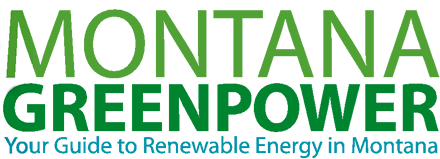Keynote Address by Secretary of State
Bob Brown�
Great Falls, October 10, 2001
For generations, Montanans have
battled the winds that buffet our prairies and tamed the forests that carpet our
mountains. Today, we have a unique chance to convert those two plentiful resources
into environmentally friendly sources of energy. All we need to do is exhibit
the same self-reliance that Montanans have always been known for. By opening our
minds to unconventional energy sources, we can nibble away at the shadow of uncertainty
imposed by volatile spot markets, terrorist acts, and climate conditions that
are beyond our control.
We can tighten our grip on our
own energy destiny. During my 30 years of involvement in state government, I've
learned a lot of important lessons. One of them seems especially pertinent here
today. My wise old friend Matt Himsl, a long-time Montana legislator, used to
say, "Never be the last in which the old has died nor the first in which
the new is tried."
Certainly, we aren't the first
to examine alternative energy options. Several other states-Texas, California,
Washington, Wyoming, and Minnesota and Pennsylvania among them-are already far
ahead of us in exploiting their wind resources. Yet Montana, which ranks fifth
among the 50 states for wind energy potential, has yet to take advantage of this
precious natural asset.
Tapping trees for power is nothing
new, either. About a third of the electricity in Scandinavian countries is generated
from "biomass," which is nothing more than stored solar energy in the
form of vegetation. The city of Burlington, Vermont, gets all its power from a
single biomass plant.
Energy from biomass can come from
agricultural waste, slash and other byproducts of logging operations, as well
as from the underbrush that clogs our western Montana forests, just waiting to
fuel wildfires. Biomass can be converted into electricity in small, high-intensity,
clean-burning generators.
As anyone who has hiked through
the forests of Montana knows, you can hardly see the trees for the biomass. That's
why, as a member of the state Land Board, I've tried to help facilitate the development
of wind and biomass, especially on the 5.2 million acres of school trust land
that the Land Board oversees. Development on those lands has the added benefit
of providing much-needed revenue for our Montana kids and classrooms. In the next
decade, the need for energy in Montana is expected to grow from about 1,800 megawatts
a year to about 2,100 megawatts.
Wind and biomass are no panacea;
they will not and cannot supplant conventional energy sources in the foreseeable
future. But they can serve us in at least four significant ways:
First, they can augment our existing
power sources and help us to feed our growing appetite for energy-sort of like
the dinner roll that complements our meat and potatoes.
Second, they can stimulate our
economy by revitalizing our wood-products industry and creating a new commodity
that we can market across the nation.
Third, they can allow us to do
our part in preserving the planet for the generations of tomorrow.
And fourth, they can enhance our
security and self-sufficiency in these dangerous and uncertain times.
Since the terrorist attacks of
September 11, we've all felt especially vulnerable and insecure. Our current power
infrastructure is vulnerable, too.
It doesn't take a Tom Clancy novel
to convince us that our pipelines and transmission lines, our electric substations
and large centralized power plants, are potential targets for terrorists who want
to throw our society and our economy into chaos. And it doesn't take a rocket
scientist to build a bomb that could cripple parts of our power grid and throw
entire regions into darkness. The September issue of Popular Mechanics describes
how to build just such a bomb and estimates that it could be done for no more
than $400 and with no more technological know-how than we had in the 1940s.
We can gain some measure of security
against such a cold-blooded act by adding wind power to our energy portfolio.
Our power supply is much less vulnerable to sabotage if it's decentralized and
diversified. Wind farms tend to be smaller than conventional power facilities,
and they can be disbursed across the landscape. Wind is currently the most promising
of the energy alternatives. And wind, as any resident of Great Falls can tell
you, is plentiful in Montana. In fact, wind is the world's fastest-growing source
of energy. It's the most economically viable source of alternative energy.
It's increasingly cost-competitive
and, unlike coal or nuclear power, it can be sold as a value-added product. The
environmentally beneficial attributes of wind can be separated from the power
and sold as so-called "green tags."
If a local community, constructed a 10-megawatt wind plant on its outskirts, the
facility could serve as a backup if the town's conventional energy sources were
disrupted-whether it was by terrorists, ice storms, or toppling trees.
Because wind is ethereal, no one
can cut off our supply. Because wind is free, inexhaustible, and available to
everyone, no cartel can monopolize it and hold us hostage to sky-high prices.
The continued development and adaptation of alternative energy sources is as certain
as the wind in Great Falls. Also as certain in the foreseeable future is the continued
use of traditional fuel sources such as coal, gas, and nuclear. The latter is
a lasting reality of nearly 100 years of infrastructure development. As we work
to embrace new technologies we must resist the temptation to place our existing
energy sources in confrontation with renewables. Rather we must embrace the opportunity
to harness the advantages of both sources today. Here in Great Falls we have an
opportunity to display the model energy portfolio for our country and the world.
The proposed construction of a
gas-fired plant provides an excellent window of opportunity to develop our wind
potential. The critics of wind energy often point to the inability of wind to
provide "firm" energy, because it isn't predictable and does not blow
100% of the time, though some of you in Great Falls might disagree with that.
In order to "firm up" wind energy we need an energy source which we
can bring on line quickly - such as a gas-fired plant. By linking the proposed
gas plant with more wind energy we achieve four important objectives for Montana:
- Increasing the number of megawatts
produced by renewables
- Reducing our reliance on conventional
sources
- Diversifying our energy portfolio
- Creating a springboard for developing
an untapped and inexhaustible Montana resource - wind
As any broker will tell you, it
makes good financial sense to diversify your stock portfolio. The same advice
holds true for Montana's energy portfolio. An investment in wind and biomass offers
a hedge against the volatility of the conventional fuel market. It boosts our
self-sufficiency and reduces our dependence on foreign oil. Wind can also play
a unique role in Montana's ongoing efforts to bolster its economy. Have you ever
stood in the aisle at the grocery store and watched someone grab a pint of Ben
and Jerry's ice cream that sells for $3.50 when we could buy a whole half-gallon
of Meadow Gold for the same price? Obviously, some other force besides economics
is driving that decision.
Just as some people are willing
to pay more for "premium" ice cream, some are willing to pay a premium
price for so-called "green" energy. Wind offers us an opportunity to
satisfy this niche market. And if we don't do it, some other state will. Wind
also presents a financial opportunity for our struggling farmers and ranchers.
In the Midwest, farmers who once cursed the gales that flattened their crops and
scoured their fields are discovering that leasing their land for wind development
is a whole lot more profitable than raising crops.
According to the New York Times,
Minnesota farmers earn as much as $2,000 a year for every wind turbine they agree
to have installed on their land. These royalty payments can provide a stable supplement
to a farmer's income, helping to counteract swings in commodity prices. Montana's
agricultural community needs and deserves this same opportunity.
Developing our wind and forest
resources can also help our economy indirectly by broadcasting our concern for
our environment. That concern projects a public image that will attract tourists
and new businesses. And alternative energy development can provide an important
source of tax revenue in rural communities whose economic futures look bleak.
As for the environmental benefits
of wind power, those are as obvious as the wind is invisible. Wind creates no
emissions that contribute to global warming or acid rain. The construction of
wind farms has a minimal impact on the landscape. And if and when they're dismantled,
they leave little sign of their existence. By developing our wind resource, we
can help to extend the lifetime of our supply of finite fossil fuels.
Biomass is also a renewable and
environmentally friendly fuel. When it's burned, it releases no more carbon dioxide
into the atmosphere than it removed from the atmosphere during photosynthesis.
For that reason, it's considered "carbon dioxide neutral."
Biomass also creates a financial
incentive to enhance the health of our forests by removing the unmarketable wood
waste that contributes to devastating wildfires. This in turn would lead to improved
watersheds, fisheries, and wildlife habitat. Montana has always been rich in the
resources of nature.
We are fortunate, and perhaps unique
among states, in that we have plenty of both wind and vegetation. When we adopted
the nickname "Treasure State" in 1895, we may not have been thinking
of our wind and forestlands, but they represent a natural treasure chest just
waiting to be opened. |


![]()